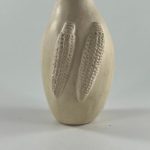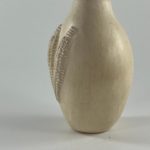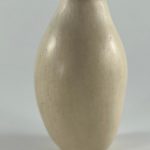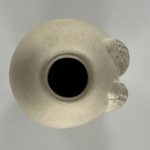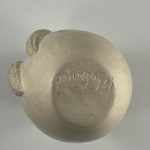Width included 0.4375″ high corn cobs.
This is the quintessent pot by an iconoclastic Hopi potter.
Polingaysi Qoyawayma (Elizabeth Q. White) led an unusual life. Born in the conservative village of Oraibi in 1892, she left her culture to live with local missionaries and received an Anglo education. She taught school for many years and, age 62, retired and began making pottery. From a village that made little pottery, she was largely self-taught and developed a unique style of unpainted pottery with repose designs, often corn. It seems that she did not make a large number of pots per year, but she continued potting for about 27 years. For a more detailed discussion of her unusual life, please see the entry for bowl 2005-08.
Form:
The jar is formed of a white kaolin clay and is vertically polished into an “onion skin” finish. While the surface is smooth, it still feels somewhat rough to my hands. The walls are even but somewhat thick, as necessitated by the repousse design. Rising off a 1.5-inch base, the jar gently slopes outward for about 1.75-inches and then turns inward for about 2.5-inches before angling upward into a 1.25-inch spout. These variations of direction are subtle and, when held in the hand, only the curve into the spout is easily distinguishable. The vase sort of feels like an egg with a spout. The name “Polingaysi” is clearly inscribed on the base.
Design:
The only design on the jar are two repousse ears of corn. The cobs are not applied to the outside of the vessel, but pushed outward from the inside while the clay was still wet. The 1-inch opening of the jar is sufficient for a finger or tool to enter the pot and the interior indentations of the cobs can be clearly felt. Each cob has six rows of corn that have been impressed with a sharp tool. Polingaysi initiated this style of design at Hopi and these repousse corn forms were directly adopted by Polingaysi’s nephew, Al Qoyawayma (2006-03) .
Design Analysis:
The shape of the jar is elegant and smooth. The white ears of corn blend into the plain white surface of the jar, from which they were formed. Thus the jar has a quiet, peaceful, quality that is centering. Third Mesa, Polingaysi’s origin, makes mostly rather heavy, undecorated, utilitarian pottery. (See “Utility Pots” in the “Category” listing.) Perhaps because it is so plain, jar 2021-02 reminds me of that heritage.


